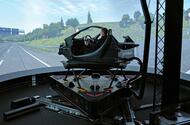Simulators have come a long way from a simple screen, fake steering wheel and set of pedals. Today’s state of the art is the motion simulator that feeds back the same kind of sensations a driver feels in a real car on the road or track.
For manufacturers of full-sized driver-in-loop motion simulators such as Dynisma and Ansible Motion, the complexity of today’s road cars and the difficulty manufacturers face in designing them can only be good news.
Dynisma, which makes the Formula 1-grade Dynisma Motion Generator (DMG) and is McLaren Automotive’s motion simulator partner, sees a new role for its product in developing advanced driver assistance systems (ADAS) for road cars.
Motion simulators are a combination of complex software and mechanics. The first creates the illusion of the world outside using a sophisticated computer model while the second generates the movement a simulator driver’s eyes tell them they should be feeling.
The challenge for simulator designers is something called latency – a delay between the visuals the computer model generates on screen and what the driver is expecting based on their actions and sensations.
In a real car, there is no latency: what the driver sees and feels are simultaneous. But however tiny, that delay in a simulator can make it difficult to get a true feeling for how the real thing would react to the driver’s inputs, say, when a car oversteers.
In the real world, a delay in reacting could mean the difference between a great save or an excursion into the undergrowth. It can also make drivers feel queasy.
How much latency is too much? Surprisingly, it’s an unthinkably small slice of time. The blink of an eye is variously reported as taking from between 100 and 400 milliseconds.
The F1 requirement for a motion simulator is less than four milliseconds, which is the time Dynisma claims for its own system.
That’s a virtually instantaneous response, says the company. It’s also fast enough to develop ADAS in simulation, such as lane keeping assistance, lane departure warning, emergency lane keeping and autonomous emergency braking.
Dynisma also has its sights set on the complex question of the handover from a vehicle driving autonomously beyond level two back to the human driver. Here, the safe environment of a simulator makes it possible to evaluate many different scenarios much more quickly.
The DMG can be used to assess passenger comfort in those scenarios too. The same simulator can also be employed in the fields of vehicle dynamics, aerodynamics, propulsion systems, noise, vibration and harshness, control systems, human-machine interface and user experience.
Dynisma expects a further use for its DMG will come next year when a new European small-series type approval regulation will dictate that small-volume manufacturers will have to adopt ADAS in their vehicles.






























